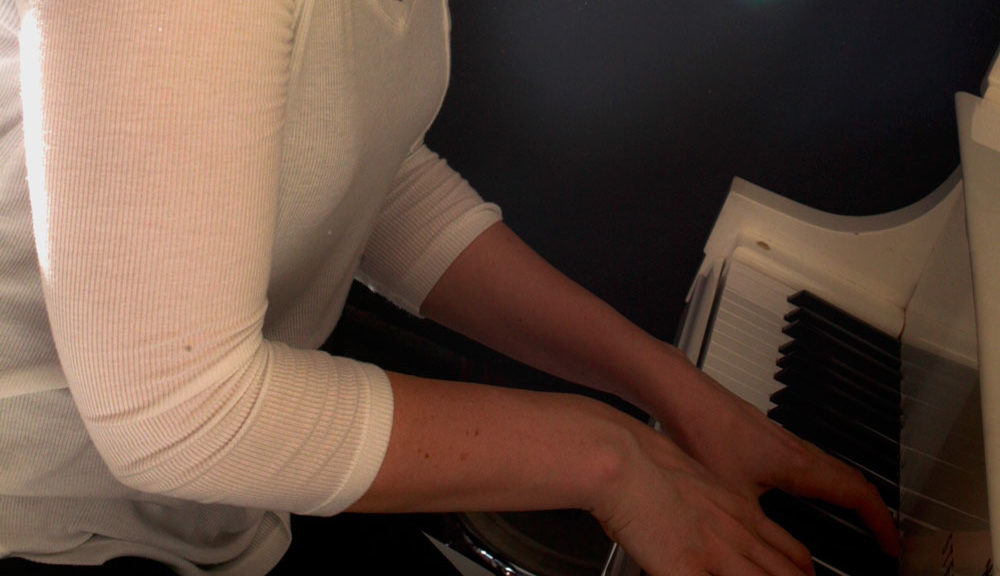
Avoiding Piano Injuries – Part 1: Posture
(This article is one of a multi-part series on how to avoid piano injuries. My goal is to 1) inform students of important basics from which they should never stray and 2) help them become aware of benefits provided by some parts of practice that may otherwise be considered boring!
I have always been interested in mechanical movement of the human body, whether studying in school or as a yoga student. While a student at Arizona State University, I studied Biomechanics as my emphasis area and graduated summa cum laude with a Bachelors of Science in Engineering. I later attended the Prosthetics program at California State University to help patients with amputations and limb deficiencies gain the ability to walk. I am pleased that I can combine my two loves, movement of the human body and music, for the benefit of my students.
It is important to me that my students develop proper technique so they can become the best pianists that their body will allow. Further, my intent is to teach my students to respect their bodies and treat them with care, to avoid injury and enjoy many years of playing.)
At the core of a healthy piano practice is correct posture. When the body is engaged, the mind is engaged, in a state of balance and harmony. Thus, the first step to establishing healthy playing habits to define posture.
Posture at the Piano
What does good posture look like at the piano? Ultimately, you want your forearms level with the ground while your fingers rest on the keys. The palm and fingers of each hand should have roughly same shape they do when your arms are relaxed and hanging at your side.
But how do you get there? Follow these three steps to check your posture – which I’ll always be monitoring during your lessons:
1. Sitting Tall
As a new pianist, this may be the most difficult part of the posture – sitting tall! This means keeping a slight curve in your lower back, pulling your shoulders back, and engaging the muscles in your abdomen for a strong core. This allows the rest of your body to move freely and your mind to focus on reading and playing music. If you have a hard wooden piano bench, you should feel your sitting bones (ischial tuberosity for anatomy nerds!) against the bench, as a reminder.
Sitting tall may be difficult at first because of the habits we have developed in our modern, sedentary lives. People are spending significant amounts of time hunched over computers, curled up on sofas and lounge chairs, and slouching at desks. All of these lead to poor postural fitness or a weak core, making it difficult to remember to sit up tall. It can be a bit exhausting when you first begin!
If good posture is not already part of your routine, it may be easy for it to slip away while you concentrate on learning to read and play music. However, to avoid development of bad habits, it is important to check in on your posture as you practice! Don’t be afraid to take a break if you’re getting tired. Schedule practice in 10-15 minute increments (also a great amount of time to help your brain as it learns, as well!).
The good news is that proper piano posture is not rigid, so the more you engage your core and support your spine, the more movement and expression will be available to you as you play.
2. Relaxed Shoulders
Now that you’re sitting tall, relax those shoulders! Shoulders should not be up by your ears. Sometimes while we’re concentrating, we hold our tension in our shoulders, which will only hurt us in the long term. However, it’s easy enough to release and just requires a gentle reminder. Usually, my students just need a soft tap on the shoulder to remind them to relax, take a deep breath, and shake it out. When you’re at home, you’ll have to keep your own good form, so try to check in with yourself every few minutes.
Another issue is hunching forward. If you’re sitting tall, this shouldn’t be too much of an issue. However, if it’s easier for you to monitor your shoulders instead of your back, hunching can clue you in to a collapse of your posture. Readjust if you notice something is off. Give yourself a break if you continue to find yourself slumping and come back later to practice.
3. Neutral Wrists
Have you ever heard of carpal tunnel syndrome? Frequently associated with office workers who spend long hours typing at the computer, carpal tunnel syndrome is a painful pinching of a nerve that runs from your forearm to your palm. With improper positioning of the wrists while playing, a pianist can also be affected. The solution – keeping a neutral wrist.
What does a neutral wrist look like? This article from the Hong Kong Journal of Occupational Therapy has a great diagram illustrating proper wrist positioning. The wrist should be “unbroken” – in a somewhat straight line with the forearm and not bent. Fingers are relaxed.
One easy check or reset is to let your arms hang gently at your sides. Gravity will naturally place your wrists in a neutral position.
Making Adjustments
1. Less thigh on the bench
You need to lean slightly forward at the piano, bending at the hips. If you’re feeling stiff or can’t seem to sit tall, sit a little more forward on the bench so your knees can angle slightly down from the edge.
2. Space between you and the piano
Especially if you’ve adjusted yourself closer to the piano on the bench, experiment with the space between your body and the piano. You don’t want to be seated so close that your elbows are behind you. Elbows should rest slightly in front of your body’s midline when viewed from the side.
3. Raise or lower the seat
To get your forearms parallel with the floor, you may need to raise or lower your bench. There are some adjustable benches on the market but you can also stack texbooks or phonebooks. These may be better options for children, since the student will likely grow into the piano over time. However, adults may want to consider an adjustable bench, particularly if they are taller and require the seat to be lowered.
4. Support for the feet
Feet should be resting on the floor while playing. Knees can be slightly lower than the bench to help allow free movement at the hip. If the feet are not reaching the ground, use a stool or stack some books to fill the space. If the student requires use of the pedal, you will want to consider a pedal extender. Otherwise, books will work just fine for children as the grow into the piano.
Posture Injury
This is a multi-part series on how to avoid injuries. Upcoming topics will cover playing technique, strategies for reducing over-repetitive playing and how the student can avoid stress by creating stillness in his or her mind. Stay tuned for more!
Related Articles Recommended for You

Read More

Read More

Read More

Read More

Read More

Read More

Read More

Read More

Read More

Read More
